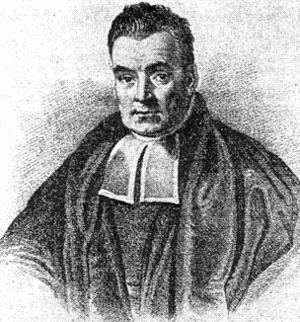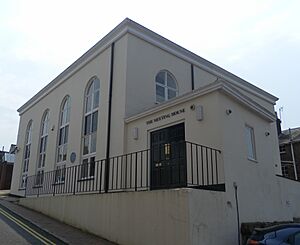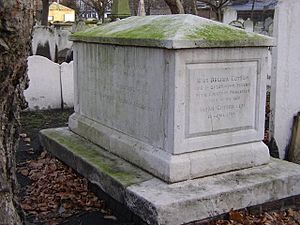Thomas Bayes facts for kids
Quick facts for kids
Thomas Bayes
|
|
|---|---|

This picture is thought to be of Thomas Bayes, but we're not completely sure!
|
|
| Born | c. 1701 |
| Died | 7 April 1761 (aged 59) Tunbridge Wells, Kent, England
|
| Nationality | British |
| Alma mater | University of Edinburgh |
| Known for | Bayes' theorem |
| Scientific career | |
| Fields | Probability |
| Signature | |
Thomas Bayes (born around 1701 – died April 7, 1761) was an English statistician, philosopher, and Presbyterian minister. He is famous for creating a special part of the math rule known as Bayes' theorem. Thomas Bayes never published his most important work himself. His notes were put together and shared after he died by his friend Richard Price.
Contents
Who Was Thomas Bayes?
Thomas Bayes was the son of Joshua Bayes, a Presbyterian minister in London. Thomas might have been born in Hertfordshire. His family was known for being nonconformist, which meant they were Protestants who did not follow the Church of England.
In 1719, Thomas Bayes went to the University of Edinburgh. There he studied logic and theology. Around 1722, he came back and helped his father at his church in London. Later, around 1734, he moved to Tunbridge Wells, Kent. He became the minister at the Mount Sion Chapel until 1752.
What Did He Publish?
Thomas Bayes published two works during his lifetime. One was about religion and the other was about math:
- Divine Benevolence, or an Attempt to Prove That the Principal End of the Divine Providence and Government is the Happiness of His Creatures (1731). This book explored how God's plan aims for the happiness of all living things.
- An Introduction to the Doctrine of Fluxions, and a Defence of the Mathematicians Against the Objections of the Author of The Analyst (published without his name in 1736). In this book, he defended Isaac Newton's ideas about calculus, which were called "fluxions" back then. He was responding to criticisms from George Berkeley, a bishop and philosopher.
In 1742, Bayes was chosen to be a Fellow of the Royal Society. This is a very old and respected group for scientists. People think he was accepted because of his math book, Introduction to the Doctrine of Fluxions. He did not publish any other math works while he was alive.
His Interest in Probability
Later in his life, Thomas Bayes became very interested in probability. Probability is the study of how likely events are to happen. Some historians think he became interested after looking at a book by Thomas Simpson from 1755. Others believe he learned about it from a book by Abraham de Moivre.
Some people also think he wanted to argue against David Hume's ideas. Hume was a philosopher who questioned believing in miracles based on stories. Bayes's work and discoveries about probability were given to his friend Richard Price after he died.
By 1755, Thomas Bayes was not well. He died in Tunbridge Wells in 1761. He was buried in Bunhill Fields burial ground in London. Many nonconformist people are buried there.
Bayes' Legacy Today
In 2018, the University of Edinburgh opened a new research center. It is connected to their computer science department and is named Bayes. This center cost £45 million and honors their former student.
In April 2021, it was announced that Cass Business School in London would be renamed after Bayes. This shows how important his work still is.
What is Bayes' Theorem?
Bayes's solution to a problem in "inverse probability" was shared with the Royal Society in 1763. This was after Bayes had died. His friend Richard Price helped make sure the work was presented and published. It appeared in a science journal called Philosophical Transactions of the Royal Society of London the next year.
The paper was called "An Essay towards solving a Problem in the Doctrine of Chances". It described a way to figure out probabilities when you have new information.
Imagine you have a bag of balls, some white and some black. If you know how many of each color are in the bag, you can guess the chance of picking a black ball. But what if you pick a ball, and you want to guess how many white and black balls are in the bag? This is an "inverse probability" problem.
Bayes's "Essay" offered a way to solve problems like this. His work is a special part of what we now call Bayes' theorem.
Understanding Bayesian Probability
Bayesian probability is a way of thinking about probability. It sees probability as how confident you are about something. It's not just about how often something happens. This means you can use probability for all sorts of ideas, not just things you can repeat many times.
The word "Bayesian" has been used in this way since about the 1950s. Since then, computers have helped scientists use Bayesian statistics with new methods. This has made Bayes' theorem useful in many areas of science and other fields.
Thomas Bayes himself might not have agreed with all the ways "Bayesian" is used today. A scientist named Pierre-Simon Laplace helped make these ideas popular. It's hard to know exactly what Bayes thought about probability. His essay doesn't explain his deeper ideas.
Bayes defined probability as a way to figure out how much something is worth if you expect an event to happen. This idea is still used in modern utility theory. This theory helps us understand how people make decisions based on what they expect to gain.
The ideas behind Bayesian statistics are very important in many modern ways of estimating things. This includes how machines learn, how we assess risks, and how we understand information. The full mathematical rules for probability were developed much later, in the 20th century.
Images for kids
See also
 In Spanish: Thomas Bayes para niños
In Spanish: Thomas Bayes para niños




